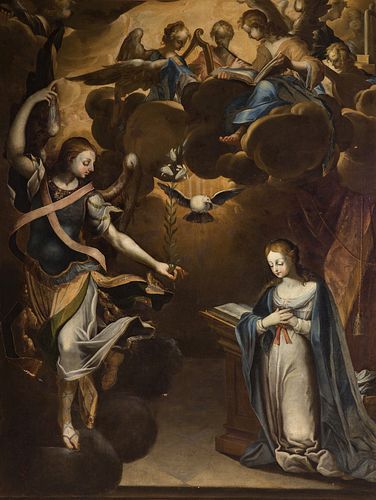Spanish School; First third of the XVII century. "The Annunciation". Oil on canvas. Relined.
Lot 61
About Seller
Setdart Auction House
Carrer Aragó 346
Barcelona
Spain
Setdart Subastas was born in 2004 and is currently the first online art auction in Spain with solidity, prestige and reliability guaranteed by our more than 60,000 users. Setdart has a young, dynamic and enterprising team ready to successfully manage the purchase and sale of art works through custom...Read more
Estimate:
EUR€8,000 - EUR€10,000
$8,602.15 - $10,752.69
Absentee vs Live bid
Two ways to bid:
- Leave a max absentee bid and the platform will bid on your behalf up to your maximum bid during the live auction.
- Bid live during the auction and your bids will be submitted real-time to the auctioneer.
Bid Increments
| Price | Bid Increment |
|---|---|
| EUR€0 | EUR€10 |
| EUR€200 | EUR€25 |
| EUR€500 | EUR€50 |
| EUR€1,000 | EUR€100 |
| EUR€3,000 | EUR€200 |
| EUR€5,000 | EUR€500 |
| EUR€10,000 | EUR€1,000 |
| EUR€20,000 | EUR€2,000 |
| EUR€50,000 | EUR€5,000 |
About Auction
By Setdart Auction House
Nov 3, 2021
Set Reminder
2021-11-03 08:00:00
2021-11-03 08:00:00
America/New_York
Bidsquare
Bidsquare : OLD MASTERS
https://www.bidsquare.com/auctions/setdart-auction-house/old-masters-7786
Setdart Auction House sofia@setdart.com
Setdart Auction House sofia@setdart.com
- Lot Description
Spanish School; First third of the XVII century. "The Annunciation". Oil on canvas. Relined. It presents important faults, repainting, losses and frame of the twentieth century. Measurements: 230 x 175 cm; 250 x 196 cm (frame). The pious Virgin, places her hands on her chest, bending her head in an attitude of receiving the good news brought by the angel. This one, standing in the composition, adopts a totally theatrical posture, which added to the elongation of the anatomy, presents a certain reminiscence linked to mannerism. In this canvas the episode of the Annunciation is represented, with a composition of long tradition that organizes the space symmetrically, with the figures of Mary and the archangel Gabriel facing each other, and the Holy Spirit in the form of a dove in the center. The scene is set in a dark interior scene, typical of the Spanish baroque, immersed in an expressive and nuanced illumination that comes from the break of glory that can be seen in the upper part of the scene. It is thanks to this illumination that the figures stand out, vividly illuminated. The classical compositional rigor acquires dynamism through the zigzagging rhythm, dynamic and distinctly baroque, which begins at the head of Mary, passes through the face and hand of the angel and culminates in the upper break of Glory, where the Holy Spirit appears. Spanish baroque painting is one of the most authentic and personal examples of our art, because its conception and its form of expression arose from the people and the deepest feelings that nestled in it. With the economy of the State broken, the nobility in decline and the high clergy burdened with heavy taxes, it was the monasteries, the parishes and the confraternities of clerics and laymen who promoted its development, the works sometimes being financed by popular subscription. Painting was thus forced to capture the prevailing ideals in these environments, which were none other than religious ones, at a time when the Counter-Reformation doctrine demanded from art a realistic language so that the faithful would understand and identify with what was represented, and an expression endowed with an intense emotional content to increase the fervor and devotion of the people. The religious subject is, therefore, the preferred theme of Spanish sculpture of this period, which in the first decades of the century began with a priority interest in capturing the natural, to progressively intensify throughout the century the expression of expressive values.
- Shipping Info
-
In-house shipping available. Please inquire at admin@setdart.com.
-
- Buyer's Premium



 EUR
EUR CAD
CAD AUD
AUD GBP
GBP MXN
MXN HKD
HKD CNY
CNY MYR
MYR SEK
SEK SGD
SGD CHF
CHF THB
THB

















